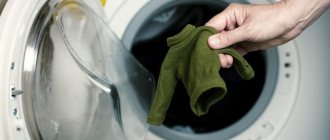Practical and beautiful artificial fabric is loved by many and is present in almost every wardrobe. The fabric is delicate and causes difficulties for housewives who do not know how to wash viscose. Things deteriorate and become deformed due to the fragility of wet fiber. The capriciousness is explained by the presence of a natural cellulose base.
Clothing and home textiles made of viscose will retain their shape and attractiveness longer if you follow washing and care rules that take into account the characteristics of the material.
Possible consequences of improper washing
- Violation of the temperature regime leads to the fact that viscose shrinks after washing. This most often happens with items that contain wool or acrylic fibers.
- Proper drying of viscose is no less important for maintaining the original condition of clothing. When you don’t have time to dry your favorite dress and have to wear it wet, there is a high probability that the product will stretch, increasing in volume by a couple of sizes.
- Viscose with the addition of polyester thread is prone to the formation of pills, spoiling the appearance of clothes. One of the reasons for their appearance is washing in a machine drum. Therefore, you need to use a laundry bag.
- For viscose items, do not use steamers or hang them on a line to dry. The material stretches from its own weight and cannot be restored.
Material shrinkage
Does viscose shrink? A pressing question that owners of products made from such fabric ask themselves in order to find out how to wash it in a machine or by hand.
Always check its composition before carrying out any cleaning procedures. Many products, as a result of improper processing, stretch or, on the contrary, can shrink, and it is almost impossible to return to their previous appearance.
Viscose shrinks when washed in the following cases:
- The fabric turned out to contain cotton, and the items were washed in hot water.
- If the label mentions polyester, be careful. Incorrect washing will cause the item to shrink.
An item sewn using 100% viscose without adding other substances is more likely to stretch. As a result, the product does not retain heat and does not emphasize a person’s shape.
Does viscose shrink when washed?
Only those clothes that are made from 100% viscose are subject to stretching. A thing with the addition of another fabric will shrink on the contrary.
Therefore, be sure to pay attention to the composition of the item. It is important. Because caring for viscose and how to wash things depends on this.
Viscose and most of its modifications are subject to deformation. If not properly cared for, things can warp, shrink, or, conversely, stretch out. To avoid such surprises, before starting any manipulations, you should study the composition of the matter. If you are holding:
- 100% viscose fabric, then perhaps the item will shrink after washing by a maximum of 4%;
- wood fiber with wool, cotton and flax can significantly decrease in size, especially when in contact with hot water and heating appliances;
- elastane and knitted fabric are stretched when intensively wrung out and hung wet on a rope or hanger.
If the viscose has shrunk, then the damp item can be stretched using an iron and simultaneously stretching the product. If it is stretched, then there is a small chance of returning it to its normal state by soaking it in very cold water.
Thus, maintaining the original appearance of the product is possible only if all care rules are followed.
How to prepare things for washing
- Start by studying the label, which indicates the temperature and washing method. For different products, care requirements may vary depending on the composition and type of fibers.
- Wash items strictly by type: light, black and colored.
- When machine washing, use a mesh bag in which the material will not rub against the walls of the drum. It will protect the fabric from snagging and pilling.
- Hooks, zippers and buttons on clothing should be fastened to avoid damaging delicate fibers.
- Wash all viscose items inside out.
- If heavily soiled, clothes should be pre-soaked. Dilute the powder or liquid preparation in a bowl of warm water (30-35°). Place the clothes there for 30-40 minutes. After this, squeeze lightly and start washing.
Automation
To prevent viscose from shrinking after the first wash, you must follow certain rules.
Before performing the procedure, you will need to study the clothing label, since a combination of different fibers is often used, and this may change the conditions for caring for things.
You should not rely on your own opinion. Follow the manufacturer's recommendations.
How to wash viscose in a washing machine correctly:
- Delicate material requires setting the appropriate mode. You can wash the fabric using the following programs: delicate or manual.
- At what temperature? Water temperature - 30 degrees.
- Dresses, sweaters or other items should not be washed in a washing machine. The fabric may shrink.
- This material cannot be dried in a machine. May stretch or shrink, again depending on the composition stated on the label.
- Pour liquid concentrate into the powder compartment.
- You can use fabric softeners.
- You can add bleach to the appropriate tray. It should be chlor-alkali-free. For viscose, it is recommended to use oxygen bleach. For example, Vanish.
Before washing, it is better to place the item in a special bag. This will reduce mechanical stress on the fabric. In addition, you can save on water and electricity by placing things in the machine that need to be washed on a delicate cycle at 30 degrees.
After washing the item, put it in the bath, carefully squeeze out excess moisture and lay it on a horizontal surface to dry.
Washing Tips
- Viscose fabrics are sensitive to direct contact with chemicals and homemade stain removers such as vinegar, ammonia, and baking soda.
- Viscose knitwear is recommended to be washed in soft water. A few drops of ammonia, which is thoroughly mixed beforehand, will help soften it additionally.
- Water with the addition of a spoonful of vinegar can refresh the color and make the fabric smoother.
- White viscose items do not fade, but are prone to staining from sunlight. This is another argument not to dry clothes in the sun. If stains have already appeared, hydrogen peroxide or oxygen bleach containing sodium hypochlorite will help remove them.
- There is no need to remove stains on viscose fabric with soap and vigorous rubbing. This deteriorates the fiber structure.
- Choose detergents that do not contain alkali or chlorine, which destroy viscose.
Practical recommendations
Viscose requires special care. During the washing process, the material loses its former strength due to exposure to water, so you should wash it carefully.
Caring for such fabric should be as gentle as possible. It is not advisable to wash things too often. So give them a break and wear different clothes.
It is not recommended to iron from the front side because it will leave a shine on the fabric. What will tell others not about the cleanliness of the fabric, but about the grease.
Viscose has good properties. The fabric is hygroscopic, quickly absorbs moisture, so traces of sweat do not remain on white things.
Taking care of things made of viscose is not difficult. The main thing is to take into account the characteristics of the material, thereby preserving its original appearance.
Subtleties of hand washing
Washing viscose by hand is not difficult at all if you follow the recommendations.
You should start with soaking. Prepare water t=30-35° with washing or suitable detergent. Hot water negatively affects the structure of the fabric and it shrinks. Immerse the items in the soapy solution, then gently wrinkle and iron the fabric. Avoid rough impact, do not rub, twist or squeeze into a ball. Wet viscose fibers are very fragile and vulnerable. They are highly prone to deformation. Shaking will help remove excess water.
How to machine wash
You shouldn’t deny yourself the pleasure of wearing viscose clothes if you don’t have the opportunity or desire to wash them by hand. A washing machine will successfully cope with this task; you just need to be properly prepared and know how to wash viscose in a washing machine.
- Items should be washed in the drum separately from items made from coarser fabrics.
- Load the clothes into the drum, placing them in the wash bag.
- Turn on the “Manual” or “Delicate” mode on the panel, set the temperature to 30°.
- Automatic spinning in a drum for viscose is contraindicated, so it must be turned off.
- Place liquid detergent or a capsule for washing delicate fabrics in the special compartment. They protect the fibers and reduce friction against the drum walls.
- If there is local contamination, you should add an oxygen stain remover, and for light-colored fabrics, chlorine-free bleach.
- When rinsing, it is recommended to use fabric softener.
Manually
Cleaning clothes made from such material is a responsible task. You cannot make a single mistake, otherwise the result will be disastrous.
If you are not limited by time frames, then it is better to wash viscose items by hand. In order for the procedure to give the desired result, strictly follow the algorithm of actions, do not abuse detergents and bleach.
How to wash viscose by hand:
- Before carrying out the manipulation, check your pockets for loose change, keys or paper bills.
- Take a clothes brush and gently remove any dust or visible dirt.
- Fill a container (bathtub, basin, bucket) with a sufficient amount of water depending on the volume of the item required to be cleaned.
- Dissolve the liquid product in water. The powder is difficult to rinse out by hand.
- Soak the product for 30–60 minutes, depending on the degree of contamination. It’s better not to let things get to the point where serious cleaning is necessary. Wear several times and wash immediately. This will make the product last longer.
- After soaking, washing follows. Carefully remove visible dirt and wipe other areas to remove dust. Do not expose the item to strong mechanical stress. Try to rub the fabric as little as possible. Squeeze the material into a fist and unclench it.
- After washing, clothes need to be rinsed. Do not expose the item to the running water from the tap, as this will cause the fabric to stretch faster. Pour water into a basin and rinse. Change the water several times. Preferably until the soap stops coming out.
You can’t twist it, and squeezing it out is also not recommended.
To squeeze out the moisture, turn the basin upside down and lean it on the bathtub so that it is slightly inclined (or use a washing board). If there is rust on the basin, it cannot be used.
Place the item on the product and leave it in this position for a while. The water should drain on its own. After 15 minutes, send the item to dry.
We suggest you read: How to properly dry an umbrella after rain
If after the first wash the item shrinks, analyze the entire sequence of actions performed. Perhaps the water was too hot.
We figured out how to wash viscose in a washing machine, however, most often manufacturers leave a note on the labels that machine cleaning is not permissible. Especially if the material is pure, without additives. Therefore, you must be able to properly wash items made from 100% viscose by hand:
- Soak the product in cold water for half an hour;
- Add detergent and a drop of ammonia, it will help soften the water;
- Gently remember and stroke the fabric, avoiding friction, squeezing into a ball, or twisting;
- Rinse in clean water;
- Shake to remove moisture;
- Place on a towel and roll into a roller, blot;
- Place horizontally on a dry towel. Dry away from direct sunlight and radiators.
About how to stretch a shrunken viscose item if something goes wrong.
Rule #4. Viscose is highly susceptible to deformation when washed. To prevent the material from stretching, it is not rubbed, twisted or dried vertically or thrown over a clothesline. To avoid shrinking, dry them away from radiators and do not wash them in hot water.
If after washing your viscose clothes still shrink, don’t worry, they can be stretched.
- Hold the item over the steam, then put it on wet and wear until dry;
- You can wet it and hang it wet on soft hangers - it will stretch out a little under its own weight;
- If the product has shrunk in some places, for example, only the sleeves have become short, dry the jacket horizontally, but periodically stretch the problem area.
Rule #5. The answer to the question “whether or not viscose stretches after washing” is definitely positive. This is why it changes shape so easily if mishandled. If the item does not shrink, but rather stretches, it must be washed once in hot water - about 60° - it should shrink a little.
Why does viscose deform and how to correct the situation?
Viscose fabrics mixed with other fibers are most susceptible to deformation. Shrinkage is more often observed in low quality products. Natural viscose is durable and serves as a strengthening additive for wool, acrylic, and polyester.
Mistakes that spoil viscose products:
- High temperature exposure and sudden change.
- The use of powders with alkali and aggressive components.
- High-speed spin in a washing machine.
- Strong friction of contaminated areas and twisting.
- Drying near heat sources.
What to do when shrinking
If you wash viscose so that it does not shrink and the size of the item noticeably decreases after washing, then you can try to correct the situation. You should start by simply pulling out the damp item, spread out on the surface. in case of shortening, wet the shirt or dress and hang it on hangers. While suspended, try to stretch it lengthwise.
If this is not enough, then wet the clothes and let the water drain. Put on damp and wear until completely dry. Hot steam while simultaneously pulling with your hands will help to stretch the product.
If the clothes are stretched
When mixing viscose fibers with wool and cotton, the products, on the contrary, stretch after washing. The following techniques will help you reduce the size, which should be chosen taking into account the exact composition of the fabric.
- Combination of viscose and cotton
Cotton is not susceptible to warping, but sometimes it still happens. Washing in hotter water than indicated on the tag, with a spin cycle at medium speed, will help restore the shape. At the end, the products are immersed in hot water with air conditioning for 10 minutes. Dry using a dryer, or spread out on a warm surface.
- With synthetic additives
Clothes are washed with high water heat and spun at maximum speed. Then they are immersed in ice water for a couple of hours. At the end of soaking, carefully squeeze and dry.
- With an admixture of wool fibers
Wool threads are highly susceptible to stretching. To reduce an item by a couple of sizes, wash it at t=+50-60°. The spin is set to the pointer position above 500 rpm. After removing from the machine, wash with cold water and dry flat on a warm, horizontal surface.
Dry cleaning
Some viscose products cannot be wet processed. Therefore, they require dry. It is safe and suitable for cleaning designer dresses, accessories, and of course, viscose carpets. If you have lost the information that was indicated on the tag, do not take risks and clean the items using the following means:
- Spot Remover. Dry substance, quickly and efficiently removes traces of coffee, grease, etc. Convenient for use in travel and public places.
- DRYEL . P&G Cleaning Kit. Good combination of price and quality, has a pleasant aroma. According to consumers, it is easy to use and does an excellent job of cleansing.
- Dry Cleaner Kit from Hagerty. Consists of substances for removing dirt from all types of fabrics and fresheners. It has no hard components. Used in drum dryers and washing machines. Does not affect the fabric, coloring or stretching of fibers, and is safe for weaving threads.
- K2r. Aerosol stain remover for any fabric. Easy to use, acts on the stain from the inside.
- Woolite-gel. Cleans knitted, woolen and knitted clothes. Does not contain aggressive components. Safe for light and colored fabrics.
- Just a minute. Cleaning gel in a tube. Apply to the stain until completely dry. The product is affordable and will even clean the carpet.
Important: dry cleaning is suitable for fabrics that are heavily or partially decorated with rhinestones, sequins, bugles or embroidery.
Rules for drying viscose clothes
- Place washed items on wooden or plastic hangers to drain. You shouldn't take metal ones - they leave traces.
- You can lay out and smooth the product on a plane, so it will definitely not be deformed.
- A towel or folded sheet will help remove excess moisture. The blouse is placed on a towel and rolled up, pressing lightly. This way, deformation will be avoided.
- Heated dryers and washer dryers cannot be used. As well as drying wet things on radiators or the active sun. Exposure of viscose to high temperatures causes deformation and shrinkage.
- To dry, items with a high content of viscose fiber should be smoothed by hand on a flat surface.
How to iron viscose fabric
Iron any item of clothing or home textiles made from natural cellulose according to the following recommendations.
- The operation should be carried out exclusively from the wrong side.
- Turn the iron on low heat.
- Iron elements and decor on the front side through gauze.
- Do not use a steamer or topical humidification from a spray bottle. Hot steam causes clothes to stretch.
- If moisturizing is necessary, use damp gauze and iron through it.










